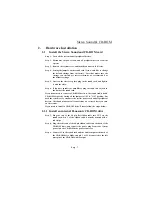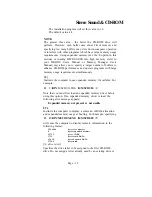
Stereo Sound & CD-ROM
specify a larger number of buffers to enhance CD-ROM
performance and operate programs with large memory
usage requirements simultaneously.
[/E]
Instructs the computer to use expanded memory, if available. For
example:
O C:\CDROM\MSCDEX.EXE /D:MSCD000 /E
Note that you must first load an expanded memory driver before
using this option. If no expanded memory driver is load, the
following error message appears:
Expanded memory not present or not usable
l/V]
Instructs the computer to display a summary of RAM allocation
and expanded memory usage at booting. For Example, specifying:
O C:\CDROM\MSCDEX.EXE /D:MSCD000 /V
will cause the computer to display memory information in the
following format:
5556864 bytes free memory
0 bytes expanded memory
12752 bytes CODE
1712 bytes static DATA
12618 bytes dynamic DATA
27344 bytes used
[/L:drive letter]
Specifies the drive letter to be assigned to the first CD-ROM
drive. Do not assign a letter already used by an existing drive or
the computer will be unable to access the CD-ROM drive. For
example, you might use:
O C:\CDROM\MSCDEX.EXE /D:MSCD000 /L:f
Normally, the CD-ROM drive is assigned the next available drive
letter on the computer after the floppy drives, hard drives, RAM
drives, etc. Therefore you only need to use this option ifit is
necessary to assign a drive letter beyond the last letter in use.
Step 3,
Create a sub-directory
CDROM
under the root directory on
your boot hard disk ( drive C in general ). Copy both files
Page - 14











































